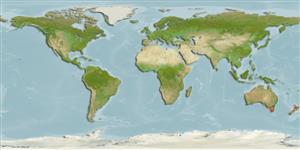Preferred temperature (Ref.
123201): 13.7 - 16.6, mean 15.1 °C (based on 164 cells).
Phylogenetic diversity index (Ref.
82804): PD
50 = 0.5000 [Uniqueness, from 0.5 = low to 2.0 = high].
Bayesian length-weight: a=0.00813 (0.00366 - 0.01807), b=3.08 (2.88 - 3.28), in cm total length, based on LWR estimates for this (Sub)family-body shape (Ref.
93245).
Nivel trófico (Ref.
69278): 3.4 ±0.44 se; based on food items.
Generation time: 6.1 ( na - na) years. Estimated as median ln(3)/K based on 2
growth studies.
Resiliencia (Ref.
120179): Bajo, población duplicada en un tiempo mínimo de 4.5-14 años (Assuming fecundity<100).
Fishing Vulnerability (Ref.
59153): Moderate to high vulnerability (52 of 100).
Nutrients (Ref.
124155): Calcium = 7.56 [1.13, 143.45] mg/100g; Iron = 0.26 [0.03, 3.04] mg/100g; Protein = 20 [15, 25] %; Omega3 = 0.413 [0.119, 1.256] g/100g; Selenium = 9.59 [1.87, 48.21] μg/100g; VitaminA = 8.38 [0.74, 84.96] μg/100g; Zinc = 0.559 [0.045, 5.986] mg/100g (wet weight);
